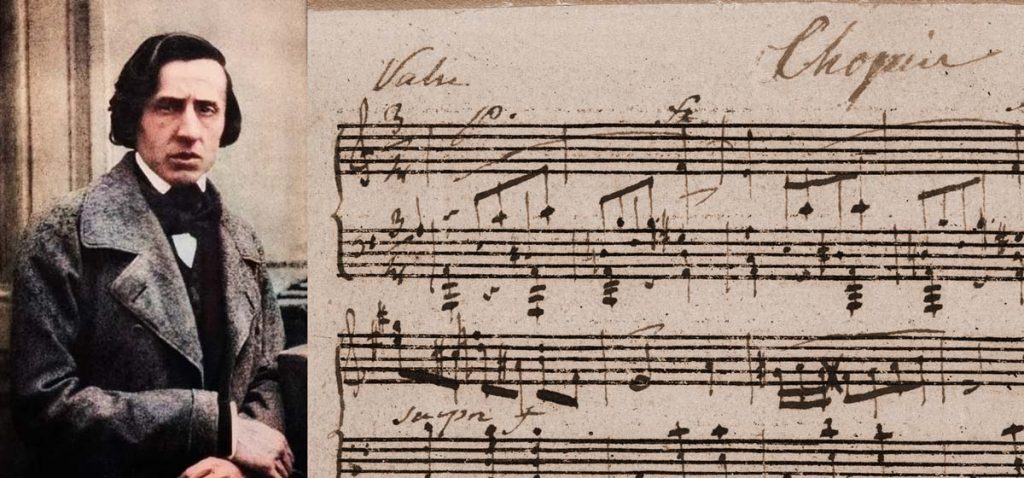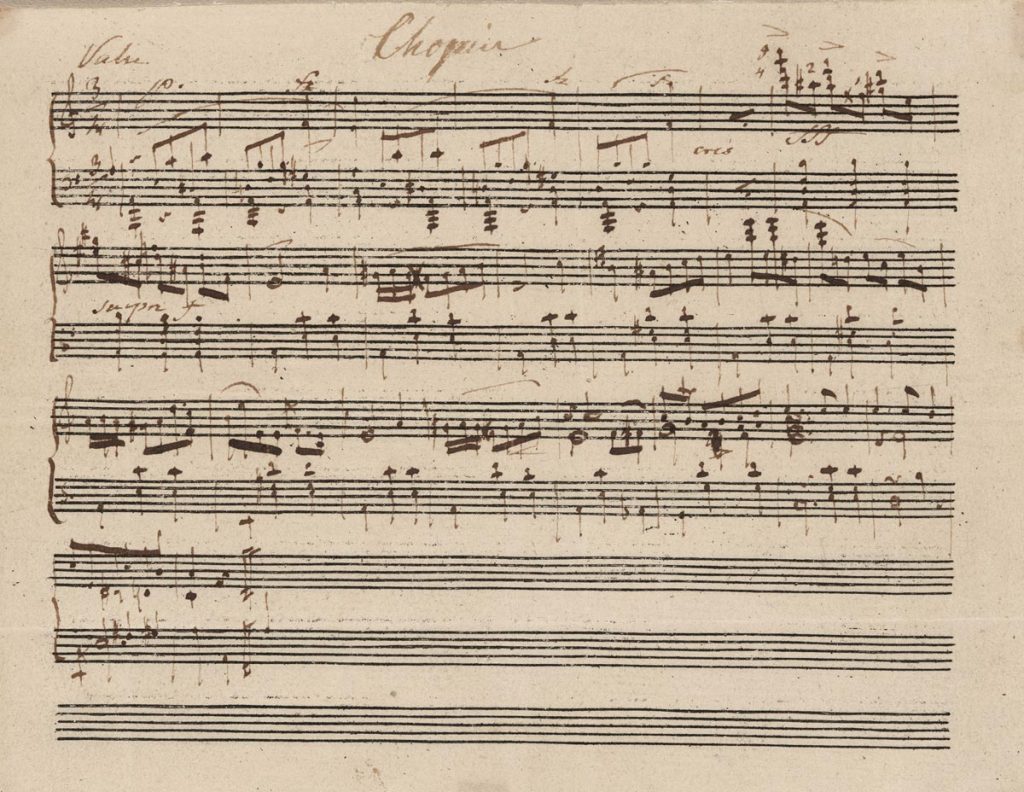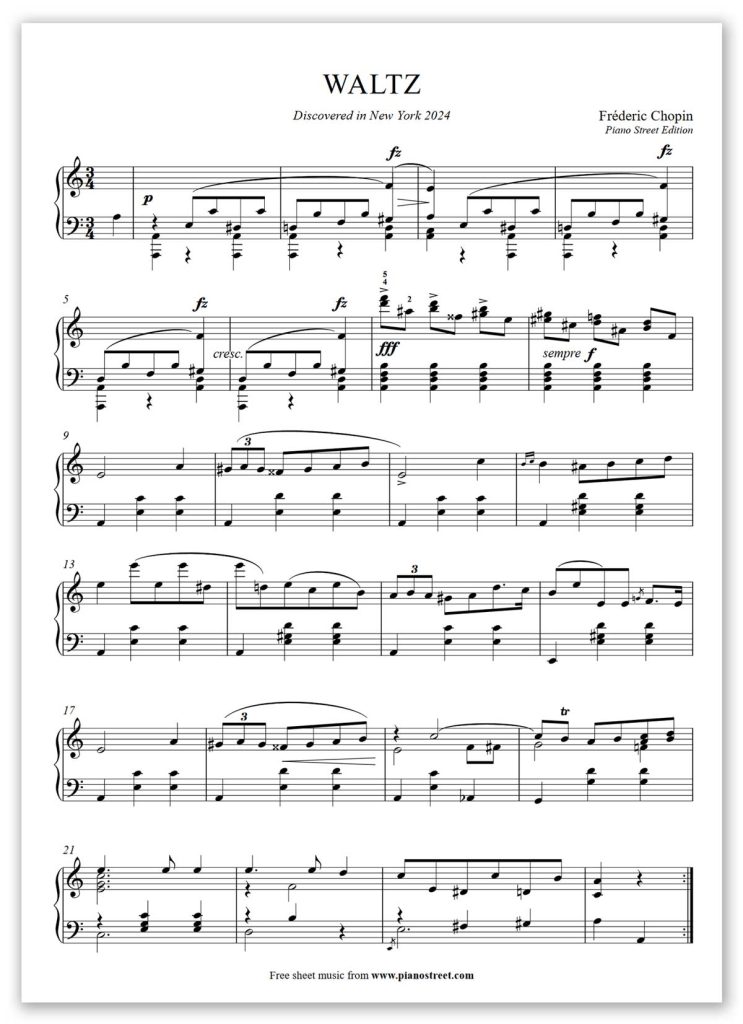New Piano Piece by Chopin Discovered – Free Piano Score
A previously unknown manuscript by Frédéric Chopin has been discovered at New York’s Morgan Library and Museum. The handwritten score is titled “Valse” and consists of 24 bars of music in the key of A minor and is considered a major discovery in the world of classical piano music. A free score is now published by Piano Street.

The index card-sized manuscript was found last spring by conservator Dr. Robinson McClellan during a routine inspection of a collection of cultural memorabilia (“Arthur Satz Collection”), also including letters from Brahms and Tchaikovsky as well as postcards signed by Picasso.
“I wondered: What’s going on here? What could this be?” McClellan explained, adding that he did not recognise the music as any of the known waltzes by Chopin. Being unsure of the work’s authenticity, he took a photo of the score and played it on his piano at home.
He sent a photograph to Jeffrey Kallberg, a leading Chopin scholar at the University of Pennsylvania, and after consulting external experts as well as the Morgan’s paper conservators, who have been analyzing the manuscript’s paper and ink as well as the handwriting and musical style, The Morgan Library concluded that the work is indeed authentic, and hence, this is a significant discovery in the world of classical piano music.

“We have total confidence in our conclusion,” McClellan said. “Now it’s time to put it out there for the world to take a look and form its own opinions.”
“This newly discovered waltz expands our understanding of Chopin as a composer and opens new questions for scholars to consider regarding when he wrote it and for whom it was intended,” he said.
The discovery of an unknown work by Chopin has not happened since the late 1930s.
“This is certainly one of the more interesting discoveries of recent years. Original Chopin manuscripts are extremely rare, and the mere suggestion that we may be dealing with previously unknown music by the Polish composer electrifies pianists and musicologists,” said Dr Artur Szklener, Director of the Fryderyk Chopin Institute.
Recorded by Lang Lang
Here you can listen to Lang Lang’s interpretation of the piece, recently recorded for the New York Times:
Lang Lang said to New York Time that the intro evoked, for him, an image of harsh winters in the Polish countryside. “This is not the most complicated music by Chopin,” he said, “but it is one of the most authentic Chopin styles that you can imagine.”
An unconventional Chopin piece or the beginning of his 5th Ballade?
While being distinctively shorter than all of Chopin’s other waltzes, it is believed by The Morgan Library that the piece is “complete”, showing the kind of “tightness” expected from a finished work by the composer.
The piece has a rather dramatic eight bar introduction, featuring some extreme dynamic markings (fff), followed by a short and simple 8+8 bars theme, and no typical ending or coda balancing the introduction.
The manuscript is not signed by Chopin but the page has the title “Chopin” at the top. Why? Is it perhaps a gift to a friend, a guest book entry, a musical joke or travesty, a transcription of something he heard another pianist play, or Chopin’s entry in some kind of compositional game with other composers? Is this an introduction intended to be continued by someone else, either composed or improvised? Add another ten pages and we have Chopin’s 5th Ballade!
The manuscript is only slightly larger than an index card (102 x 130 mm, about 4 x 5 inches). Based on other similarly-sized manuscripts by Chopin, researchers assume that it was meant as a gift for inclusion in someone’s autograph album. “More than half of the waltzes that we know today remained unpublished during his life because he had given them as gifts,” Kallberg said.
Play it now from our new score!
For anyone who wants to try to play the piece, we prepared a free Piano Street Edition for you to download and print:
Chopin Waltz in A minor – N.Y 2024 (Piano Street Edition)
When working on the score which is based on the photos of the manuscript, we noticed some odd notations:
– The triple F dynamic in bar 7 is unusual for Chopin and “Sempre f” in bar 8 is not followed by any other dynamic instruction. While the theme is intimate and melancholic in its character, if following the dynamics litterally, the whole theme should be played “forte”, or even “fff”?
– In the “E7” dominant chord in bar 7-8 (G#dim/A) the first beat of bar 8 could have been notated as F natural (minor 9th) instead of E#.
– The first beats of bar 10 and 15 are notated as 16th notes instead of 8th note triplets.
Your opinion?
What do you think about this “new” Chopin piece? And does is qualify as a complete composition by Chopin or a is it a draft that was intended to be continued?
Should it be included in our sheet music library’s list of complete composition by Chopin?
Please post your comments below!
Further reading:
Comment by Dr Artur Szklener, Director of the Fryderyk Chopin Institute

Comments
What an exciting find! Thanks for the score. Very clear to read! I will go ahead and learn it and come back later with my verdict.
For me, it seems to be a sketch for a Mazurka, Scherzo more than a normal Vals.
But, why not a dramatic Vals. The consequences of this start gives a lot of ideas for a continuing.
I found the manuscript online yesterday but really struggled to play from it. Your score makes it much more accessible. Thank you!
I heard that when they turned the manuscript page over they realized it was sketched down on the reverse side of his Chopin list! ;-)
Very exciting news for all Chopin lovers. I totally agree with Soren’s comment. I wish there were another 10 pages and that this was just the beginning of a longer piece. Let’s hope they find the other pages soon!
Worthy of publishing certainly sounds like Chopin but sounds like the beginning of An Unfinished work
Based on expert analysis, I think this piece should be included in your Chopin collection for several reasons: Just like the Prelude in A, it is short and easy enough for students to grasp/handle plus Lang Lang’s interpretation “has Chopin all over it” and it is exciting to add a new discovery of an old piece by a genuine master into the body of Piano Street music! Well done. Thank you Piano Street for making this music available to me and my students. Bravo!
It is so emotional to me! Almost to tears! What an experience in just a few bars! Can’t say enough.
A complete idea, but not a complete piece. The animated FF passage set against the sweet waltz cries out for a more developed piece. Perhaps Chopin succumbed to his fatal illness before continuing?
Definitely include it. It is, at least to my ear, a work by Chopin, but as others have suggested, it seems clear to me that it was an idea in progress of becoming a bigger work. The sudden end of that thematic beginning just implies more to come. Even the appearance of the actual manuscript seems to suggest that.
Well, I am of course going against everything but I cannot imagine that Chopin is the composer of this. It is so simple and too poor in harmony. My profession is ballet pianist, my colleagues and I improvise such pieces daily and often better ones! A further and thorough analysis and a close comparison with real waltzes by Chopin seems to me to be in order.
Perhaps Chopin used this small paper to just “snapshot” a musical idea that came up to him somehow unexpectedly, or at least under less ideal circumstances for a composer to work? Like genuine melancholy visiting him unannounced? Perhaps this small and easily lost “scribble” tells us more about his melancholy to be genuine and unpredictable, not just sought or sighed for, honest as to when and where it came to him, also where it often was to be expected and conceived by a professional composer as he was. Scribbled melancholy as the purest.
I accept it is genuine Chopin. I have a problem with Lang Lang’s interpretation*. It sounds more like a lost piece by Rachmaninov in his playing. I think the fff markings need to be interpreted considering the dynamics of Chopin’s piano, the Playel, and Chopin’s technique which we know from multiple observations was not thunderous. The fff on a modern Steinway is a very different sound indeed than anything Chopin had imagined.
I think there are some similarities to Op 69 #2 harmonically and as with the Op 69 #1 a similar sad/whimsical element.
I suspect all 3 were written at much the same time.
Just my thoughts.
* I consider Lang Lang one of the true greats
Seems uncharacteristically short and undeveloped for Chopin or for that compositional period in general.
Since there seems to be no doubt that it’s by Chopin why leave it out of Chopin’s complete works
Whether or not it is truly by Chopin, it is a lovely little thing, and thank you to Piano Street for preparing it for us in a format we can actually use! Much appreciated :)
No doubt at all that it is authentic. Somehow I could see this somewhere in the Preludes… even in its present form.
A musical doodle. It gave me a lot of pleasure to play. Real Chopin or not, the peace gives you a nice romantic picture of Poland
Thank you very much for making this available so quickly and clearly. It is an interesting and enigmatic addition to the information we have about Chopin.
I don’t actually care about this composer. Where is Messien ? I think they should shuve that dirty scrap of trash right back wheare they found it and level the building with a green bulldozer!
I tend to agree with Söre Unge’s suggestion of this being a mazurka sketch. If the sixteenth notes beginning bars 10 and 15 were preceded by an 8th note rest and the 16th notes played as a triplet or as a mordent, this would be more in character as a mazurka.
Having played it many times – too my mind it fealls more like a ballade – both in tone and feeling!
I have to agree with Arjo de Koning on this; it’s poor, simplistic and easily the sort of pastiche ballet pianists improvise daily! The genius of Chopin is really lacking. Lang2’s rending only emphasizes the emptiness.
I am trying to see the connection between the piece of newly founded Chopin, comparing it to either one of his Waltzes or better yet, Mazurkas. I would play this short stick in a minor into the category of a beginning Mazurka in a minor which upon arriving at the end, the composer would continue extending the material into C Major before heading back to a minor and a short conclusion.
It reminds me somehow of Ballade No. 4 Op 52.